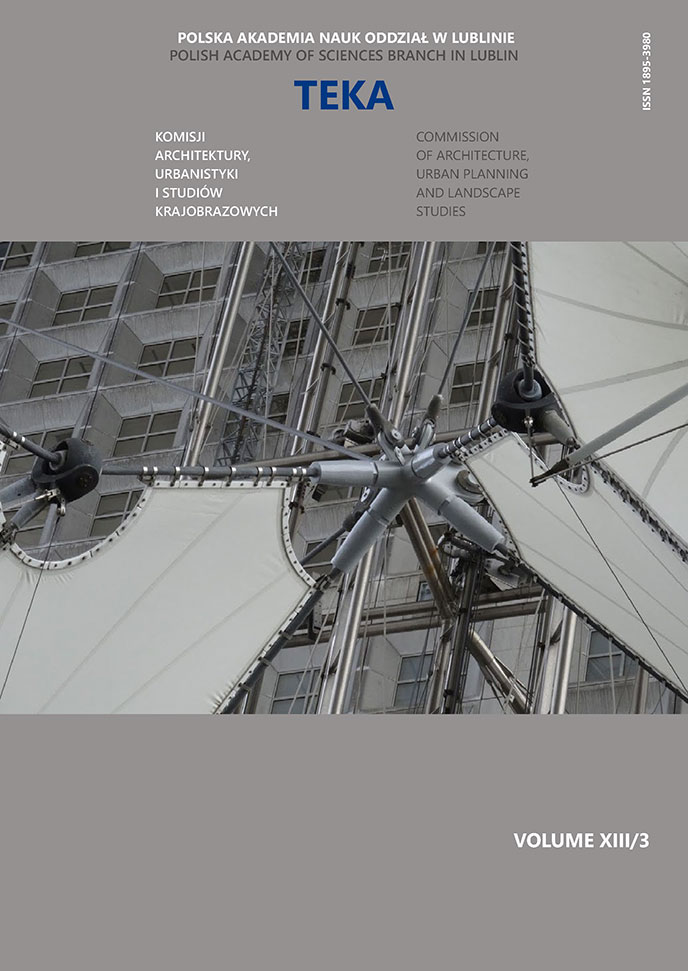Shooting sport in the context of military objects in the middle war period of Poland
Article Sidebar
Open full text
Issue Vol. 13 No. 3 (2017)
-
About historic stonework in Kraków
Anna Kulig7-13
-
Wstęp do metodologii oceny dotykowych modeli architektonicznych
Maciej Kłopotowski, Agnieszka Kłopotowska14-24
-
O mieszkalnictwie początku XXI wieku. Próba charakterystyki na podstawie europejskich realizacji
Maciej Kłopotowski25-42
-
Od rewaloryzacji idealnego miasta do ochrony historycznego krajobrazu Zamościa
Krzysztof Kazimierz Pawłowski43-52
-
Neolityczne megality Nałęczowa – debiut budownictwa na Lubelszczyźnie
Natalia Przesmycka, Lucjan Gazda53-59
-
Optimization of barrel vault surfaces using energetic potential method
Kajetan Sadowski60-66
-
“Straszny Dwór” (Haunted Manor) guesthouse in Tatarów in the Hutsul region and its designer Jerzy Romaszkan
Jacek Czubiński67-77
-
Participation of Stanisław Tomkowicz in the conservation of the Corpus Christi collegiate church in Biecz
Jacek Czubiński78-85
-
Shooting sport in the context of military objects in the middle war period of Poland
Wojciech Kocki, Elżbieta Przesmycka86-92
Archives
-
Vol. 15 No. 4
2019-12-30 6
-
Vol. 15 No. 3
2019-10-31 9
-
Vol. 15 No. 2
2019-06-28 12
-
Vol. 15 No. 1
2019-03-29 13
-
Vol. 14 No. 3
2018-10-28 14
-
Vol. 14 No. 2
2018-06-29 14
-
Vol. 14 No. 1
2018-03-30 13
-
Vol. 13 No. 4
2017-12-29 8
-
Vol. 13 No. 3
2017-09-29 9
-
Vol. 13 No. 2
2017-06-30 10
-
Vol. 13 No. 1
2017-03-31 10
-
Vol. 12 No. 4
2016-12-30 12
-
Vol. 12 No. 3
2016-09-30 10
-
Vol. 12 No. 2
2016-06-30 9
-
Vol. 12 No. 1
2016-03-31 8
-
Vol. 11 No. 4
2015-12-30 14
-
Vol. 11 No. 3
2015-09-30 7
-
Vol. 11 No. 2
2015-06-30 8
-
Vol. 11 No. 1
2015-03-31 11
Main Article Content
DOI
Authors
elzbieta.przesmycka@pwr.edu.pl
Abstract
During the interwar period, sport played many special roles in Polish society at that time. In the unstable political and economic situation as well as during the first years of the interwar period when attempts were made to rebuild the Polish State after regaining independence through sport, it was possible to keep the society in increasingly better physical condition. This situation was conducive to strengthening citizens for a possible armed conflict. The Government’s limited budget and possibilities for financing the development of the army resulted in the formation of associations, clubs and paramilitary organizations that promoted the cultivation of physical agility. A few years after the end of World War I and the country’s increasingly better situation began to blur the boundaries between education and development of military physical culture and society through joint organizations and the possibility of using more common groups of people, especially shooting sports. Shooting as a sport was considered to be key in military terms. Already during the partitions, the partitioners built shooting ranges, which in the early interwar years were adapted to the needs of the country. Examples of shooting ranges from middle war period in Lublin were: Project of shooting range Kolejowego Przysposobienia Wojskowego named of Pułkownika Lisa-Kuli, Project of shooting range Związku Strzeleckiego in Dziesiąta disctrict, Project of shooting range of Lubelskiego Towarzystwa Łowieckiego near Dolnej Panny Marii street.
Keywords:
References
Czaboćko J., Symbioza sztuki ze sportem, Prace Instytutu Kultury Fizycznej nr 26, Zeszyty Naukowe Uniwersytetu Szczecińskiego, 2009. s. 8
Mały Rocznik Statystyczny, 1939 rok, hasło związki Sportowe, s. 305, GUS RP
Ponczek M., Początki i rozwój polskiej kultury fizycznej na Górnym Śląsku do 1945 roku, Prace Naukowe Akademii im. Jana Długosza w Częstochowie, Seria Kultura Fizyczna z. XII. Nr 1, 2013 s. 3
Szubert R., Kultura fizyczna w przemianach wsi polskiej w latach 1944−1956, Studia i Monografie Akademii Wychowania Fizycznego we Wrocławiu, Nr 100, Wydawnictwo AWF, Wrocław, 2010, s. 10−18, 112−145.
Szujecki K., Gawryś Z., Mijakowski K., Dwudziestolecie Międzywojenne, Tom 15 SPORT, Wydawca Editpresse Polska SA, 2013 s. 34−36
Article Details
Abstract views: 205


